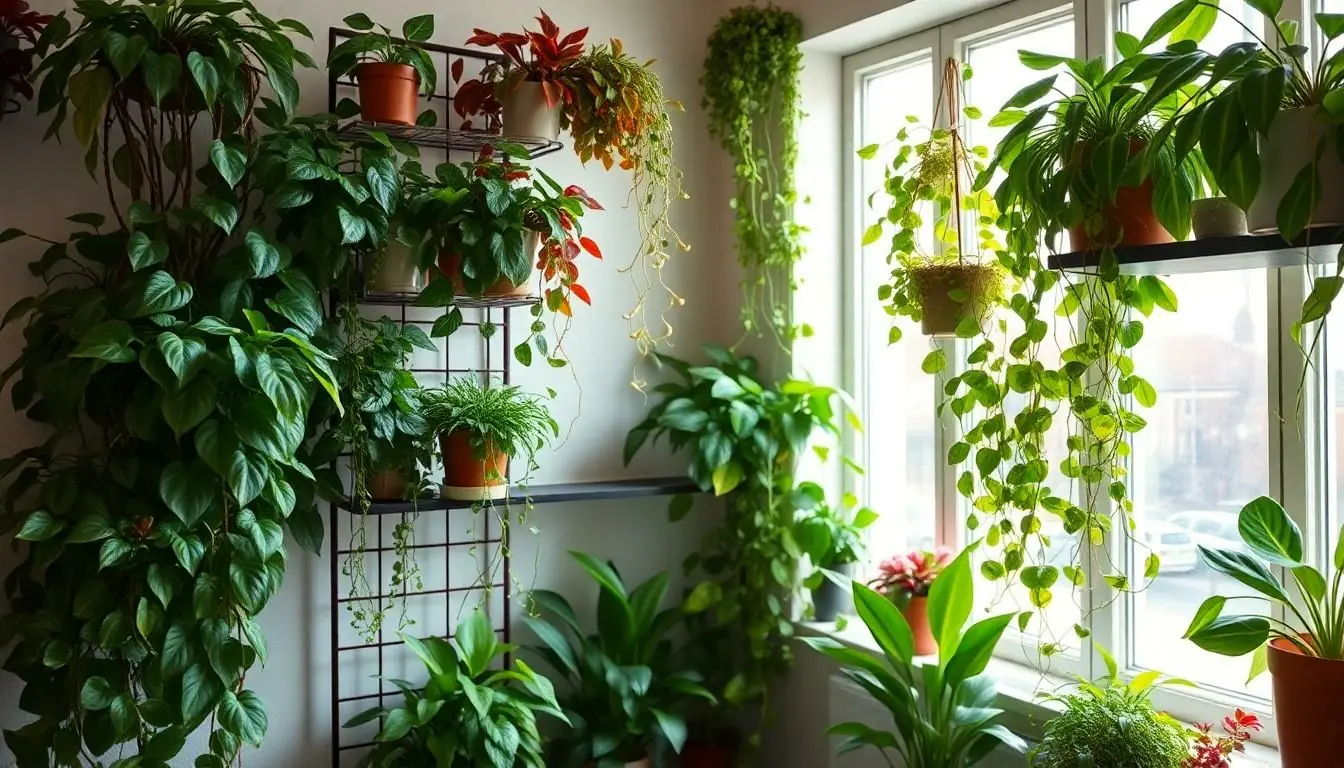Table of Contents
ToggleImagine transforming your living space into a lush jungle without the need for a passport or a hiking boot. Climbing house plants are the unsung heroes of indoor gardening, effortlessly adding a touch of nature while showcasing their adventurous spirit. These green companions not only bring life to dull corners but also provide a delightful vertical dimension that can make any room feel more expansive.
Whether you’re a seasoned plant parent or just starting out, climbing plants offer a unique way to express your style. From the charming pothos that practically begs to be draped over shelves to the regal philodendron that climbs like it’s auditioning for a Broadway show, there’s a perfect match for every home. So, let’s dive into the world of climbing house plants and discover how to elevate your indoor oasis with a little green flair and a whole lot of personality.
Overview of Climbing House Plants
Climbing house plants thrive on vertical growth, bringing life to spaces. Varieties like pothos and philodendron are popular for their ease of care and adaptability. Such plants exhibit lush foliage and vibrant colors, enhancing any room’s decor.
Support structures, like trellises or shelves, help these plants showcase their climbing capabilities. Different species vary in light and water requirements, allowing for diverse placement options. Homes filled with climbing plants benefit from improved air quality due to their natural filtration systems.
Plants such as the ivy are renowned for their fast growth and ability to cover large areas, making them ideal for adding greenery to otherwise empty walls. Climbing plants can thrive in low or bright indirect light, catering to various indoor environments. Their ability to live in different potting conditions makes them suitable for both beginners and seasoned enthusiasts.
Pairing climbing plants with hanging baskets or support systems creates depth and visual interest in any setting. Regular pruning encourages fuller growth, enhancing their aesthetic appeal. Those who embrace climbing house plants contribute to a calming, serene atmosphere indoors.
Benefits of Climbing House Plants

Climbing house plants offer numerous benefits that enhance both aesthetics and health indoors. They play a vital role in creating a lively atmosphere in any space.
Enhancing Indoor Air Quality
Climbing plants such as pothos, philodendron, and ivy significantly improve indoor air quality. They absorb harmful pollutants like formaldehyde and benzene, which frequently exist in homes. Increased oxygen levels from these plants contribute to a healthier living environment. Notably, NASA’s Clean Air Study demonstrated that certain plants can remove toxins, making them perfect choices for indoor gardening. Homes filled with climbing plants not only breathe better but also promote overall well-being for residents.
Aesthetic Appeal and Design
The aesthetic appeal of climbing house plants cannot be overstated. They add visual interest, creating depth with their lush foliage and vibrant colors. These plants can be used on trellises, shelves, or as decorative wall accents, transforming dull spaces into engaging focal points. Climbing varieties allow for creative arrangements that fit various interior design styles. Pairing them with hanging baskets offers a dynamic layered effect, enhancing the artistry of indoor decor. With proper care, climbing plants thrive, ensuring long-lasting beauty.
Popular Types of Climbing House Plants
Climbing house plants offer diverse options that enhance indoor environments. The following selections are particularly popular and easy to care for.
Pothos
Pothos, also known as Epipremnum aureum, thrives in various lighting conditions, from low light to bright indirect sunlight. This hardy plant features heart-shaped leaves, which often exhibit variegation in shades of green and yellow. It’s adaptable, handling irregular watering and forgiving occasional neglect. Given its fast-growing nature, pothos can quickly cover structures like trellises or shelves. Regular pruning encourages bushier growth, creating an attractive display.
Philodendron
Philodendron plants belong to a large family, recognized for their lush foliage and unique shapes. Dark green leaves typically grow in a natural, cascading manner, making them excellent climbers. They thrive in medium to bright indirect light, and their care routines are straightforward. While regular watering is essential, allowing the top layer of soil to dry between watering helps prevent overwatering issues. Philodendron varieties enhance indoor spaces with their beautiful forms and adaptability to different home styles.
Hoya
Hoya, or wax plants, charm with their thick, waxy leaves and often fragrant flowers. This versatile plant thrives in bright, indirect light and enjoys warmer conditions. Hoya varieties can showcase stunning clusters of star-shaped blooms, adding visual interest to any area. They prefer drier soil; allowing the soil to dry out between waterings suits them well. These traits make Hoya ideal for both new and seasoned plant owners, promoting easy maintenance while enhancing indoor decor.
Care Tips for Climbing House Plants
Ensuring proper care for climbing house plants enhances their growth and vibrancy. Focus on specific factors to maintain healthy and thriving plants.
Light Requirements
Climbing house plants thrive under bright, indirect sunlight. Many varieties, such as pothos and philodendron, adapt to lower light levels, but optimal growth occurs in brighter conditions. Observe the placement; near east or west-facing windows usually offers suitable light. Monitor leaves for signs of light stress; yellowing or leggy growth indicates insufficient light. Rotate plants periodically to promote even growth and prevent leaning toward the light source.
Watering and Humidity
Watering habits directly influence climbing plant health. Allow the top inch of soil to dry before watering again, ensuring the roots avoid rot. Humidity plays a significant role in plant vitality as well. Many climbing plants prefer higher humidity levels, ideally between 50% and 70%. Misting leaves occasionally or using a humidity tray can enhance moisture retention. Regular monitoring of soil moisture keeps plants hydrated without overwatering, thus promoting lush and vibrant foliage.
Fertilizing
Fertilization supports climbing plants through their active growth cycles. Use a balanced, water-soluble fertilizer every 4 to 6 weeks during spring and summer. Focus on diluted feeding to prevent nutrient burn. Observe plants for signs of nutrient deficiencies, such as pale leaves or stunted growth. Reducing fertilizer frequency during the fall and winter months helps maintain nutrient balance, ensuring healthy foliage year-round.
Decorating with Climbing House Plants
Climbing house plants add unique dimensions to indoor spaces. Their versatility allows for creativity in decor.
Vertical Gardens
Vertical gardens create stunning green walls that enhance any living area. They utilize wall space efficiently, making rooms appear larger and more inviting. Selecting fast-growing plants like pothos or ivy works well, as they quickly cover vertical surfaces. Those who choose to arrange their climbing plants in patterns can create eye-catching displays. Incorporating planters with different textures and colors amplifies visual interest. Vertical gardens contribute significantly to air quality, filtering harmful substances. Their lush foliage introduces tranquility, transforming plain walls into vibrant statements.
Using Trellises and Supports
Trellises and supports elevate climbing plants while offering structure. These accessories allow gardeners to control plant growth, guiding vines where desired. A variety of trellis styles, from rustic wood to modern metal, suit diverse interior designs. Plants, such as philodendron or hoya, thrive with adequate support, enhancing their natural beauty. Hanging pots and wall-mounted shelves provide additional options for displaying plants. Regular pruning keeps climbing plants healthy and encourages fuller growth. Strategically placed supports create depth, making the decor dynamic and engaging.
Climbing house plants offer a unique way to elevate indoor spaces while enhancing overall well-being. Their versatility allows for creative arrangements that fit various decor styles, turning dull corners into vibrant focal points. With minimal care requirements, even novice plant owners can enjoy the beauty and benefits these plants bring.
Incorporating climbing plants not only improves air quality but also creates a calming atmosphere that promotes relaxation. By utilizing support structures and practicing regular maintenance, anyone can cultivate a lush indoor garden that thrives. Embracing climbing house plants is a simple yet effective way to invite nature indoors and enrich daily life.




